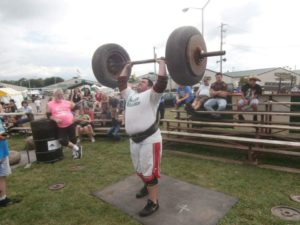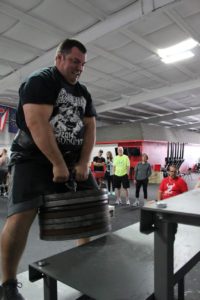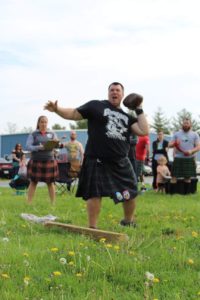Rocco Walsh is chasing a strength sports trifecta. He wants to compete at the highest levels possible in powerlifting, strongman and Highland Games! He’s not alone. Unlike the purists of the past, or maybe MORE like the athletes of the Physical Culture era, todays strength athletes are hungry to test themselves in any way it’s possible to measure strength and power. Let’s learn more about him!
How did you get into Highland Games? Do you have a track and field background?
I actually got into Highland Games about 3 years ago. Before that, I had competed in Strongman and Powerlifting for several years. I competed in a Highlander event in Lorain, Ohio in August of 2015 and that’s when I really got the bug to start throwing and eventually make the conversion to Highland Games from Strongman competing. I don’t have a background in track and field.
You compete in powerlifting as well as Highland Games with a 430lb bench in 2018 to break the Kentucky State submaster bench press record in the Next Generation Powerlifting Federation. What are your other accomplishments outside of Highland Games?
Correct, I currently compete in the NGPF and look forward to some more competitions this year, primarily bench/deadlift events. Some of my other accomplishments include 2009 NAS Police/Fire/Military Heavyweight National Champion. That same year I won the Xenia, OH Fall Festival Strongman in the super heavyweight open class. I have several top 3 finishes as well in local shows over the years, mostly competing in Xenia, OH where I got my start in Strongman.
 How was the transition to becoming a Games athlete? What surprised you about the training or the competitions?
How was the transition to becoming a Games athlete? What surprised you about the training or the competitions?
The transition initially was challenging. Having spent many years competing in Strongman, you’re used to applying a lot of maximum effort to certain events. Highland Games events are extremely technical, and it takes a lot of patience to develop proper technique. The first year, even first couple of years was a challenge at times to get even the most basic technique down. Luckily, I am blessed with a great love for competing and strength sports in general. That allows me a degree of patience to apply to the process. Even 3+ years into it, I have a ton to learn, lots of improvement to be made and I love every minute of the process!
You said that your goals include bench pressing 500lbs, deadlifting 600lbs and move up to compete in the A class in Highland Games. Do you find that training for both sports complements or hinders those goals?
Correct. My ultimate goals in powerlifting would be to bench 500lbs in some capacity (either raw or equipped) and deadlifting 600lbs on the platform. With that said, my ultimate goal in Highland Games would be to win in the B class and move up and be competitive in the A class. Training for both sports ultimately just makes you stronger and more proficient in each discipline. But what I try to do, is focus the training cycles for the event that I will be competing in. Highland Games require certain movements over others, so I will do my best to focus the training to match up for Highland Games or powerlifting. One principle that does carry over well for both sports is including dynamic effort days for both upper and lower body. For instance, doing speed squats/deadlifts with bands or chains to develop some explosive power.
What’s your Games record so far?
- 2015 Columbus IN Scottish Games – C Class, 4th place
- 2015 Indianapolis IN Scottish Games – C Class, 5th place
- 2016 Columbus IN Scottish Games – C Class, 3rd place
- 2016 Indianapolis IN Scottish Games – C Class, 2nd place
- 2017 Columbus IN Scottish Games – B Class, 8th place
- 2017 Indianapolis IN Scottish Games – B Class, 9th place
- 2018 Magnus Mayhem Highlander Indianapolis IN – Heavyweight Open, 5th place
There are some efforts being made regionally to open the sport to lighter weights but traditionally Highland Games is a sport that’s primarily for taller, larger strength athletes. With events like the caber toss being more suited to larger athletes who can use their bodyweight to counterbalance the caber, are you concerned that bringing in lighter weight classes might cause things like the caber toss to go away?
No, the caber toss is the big money event in Highland Games. That is the big spectator draw at Scottish Festivals, and they will use smaller/larger cabers based on the weight class or competition level.
Former Highland Games World Champion, Matt Vincent, and former thrower, Chad Wesley Smith have both said that training in the gym only gets you so far. Daniel McKim, who is also a multiple time Games World Champion said he believed in maintaining his training intensity throughout the season. How do you balance training in the gym and skills training?
multiple time Games World Champion said he believed in maintaining his training intensity throughout the season. How do you balance training in the gym and skills training?
Optimally, I try to do a 4 day/week training split with at least 2-3 throwing sessions per week as well. But in all honesty, life takes hold with job, kids etc, and I have to get the training and throwing in when I can. During the throwing sessions, I try to rotate the events as best as possible. I have hammers, stones, weights/distance and a small training caber that I can use at home.
The caber toss is probably the most recognizable Highland Games event. I used to work on a powerline crew and occasionally had to climb poles like the caber. How does it feel to pick up and throw something that people climb up to hang lights and power lines on?
To be honest, most of the time I just treat it like its training for any other event or lift. But sometimes I do take a step back and realize its pretty cool to even be attempting something like a caber toss. The challenge to try and conquer an object so large is incredible, and its an even greater feeling when you’ve turned the caber!
Daniel McKim also said that he found his first Games training equipment at a Landscaping supply that sold river rocks. Where do you get your training equipment, especially the caber?
That sounds about right. There is definitely some DIY involved, mixed in with other aspects. I purchased my 22lb hammer weight from a Highland Games company, but I’ve made the hammer shafts from pvc. The 22lb weight then goes on the end of a pvc shaft to make the heavy hammer. I have a couple of standard plates (5/10lb) that I can attach to a pvc shaft for a light hammer (16lb). For my caber, I just went into the woods and cut down about a 12 foot tree on my property. Its rough, but it does the trick. I also purchased an implement from Sorinex, called the ballistica which is a plate loaded pin with ring shackle. That implement is fairly versatile. You can use it for weight for height, distance throws or attach a chain to it to mimic hammer throws. I’ve also used the same implement to train power stairs, which was an event in a recent Highlander competition that I was in.
I was surprised to find out that for the Sheaf Toss, you’re supposed to provide your own pitchfork. Where do you get a Games legal pitchfork and do you get strange looks trying to get a pitchfork onto an airplane?
For the most part, there are several different forks for use at many Games. Not all, but in my limited experience…there has been some type of sheaf fork available to use. You can purchase either a 2-tine or 3-tine fork from several different HG companies. Those same folks, also more than likely make and sell the sheaf bags as well. Sheaf is the one event that I do not have the equipment yet, so luckily I haven’t had the experience of funny looks while travelling with a pitch fork!
The most common advice I’ve seen for how to get started is to find an event, sign up as a novice and just jump right in because of how helpful competitors are to each other. Describe your first Games experience. How did it go and where was it?
That is correct. If you are brand new, you can browse to the NASGA website (www.nasgaweb.com) and check their database to find a Games near where you live. Most of the time, you start out competing in the C class. Fellow throwers are some of the best resources you can find in addition to the fact that they are some of the funniest and most down to earth people you will meet. My first Highland Games was in September 2015 in Columbus, Indiana. I ended up finishing fourth, met a bunch of great folks and had a blast. I would say my favorite part was probably turning the caber twice that day. A close second, is all of the help and advice you get from fellow throwers and the field judges.
 What do you know now that you’ve got some time in that you wish you’d known when you started?
What do you know now that you’ve got some time in that you wish you’d known when you started?
It would probably be just applying some of the tips and advice that I’ve been fortunate enough to receive over the last couple of years. Another thing would be that some of the events start slow to fast. For example, weights for distance; the spin technique starts out slowly and then builds to fast feet and an explosive throw.
I really enjoyed watching Highland Games at the Arnold. I heard Janine Kuestner describe the experience of competing there for the first time and she mentioned the differences between competing indoors and outdoors. Have you competed indoors as well as outdoors?
I’ve only competed outdoors thus far, so I don’t have any competitive experience indoors. However, I have volunteered at the Arnold Indoor Highland Games and there are certain events that can’t be done indoors. For instance, hammer throws can really only be done outdoors do to the size of the field or throwing space needed. It was still a lot of fun though to see our sport on one of the biggest stage in Strength Sports.
You do a fair amount of skill training at home. You said on Instagram that your neighbors think you’re crazy; What’s the weirdest thing they’ve seen you do?
The strangest would probably have to be watching me get on a ladder and tie a long string between two close trees. A couple of years ago, we had 2 two large trees in close proximity to each other. I put a nail into each tree at heights of 11 and 12 feet and tied a string to each in order to train weight over bar. I’m sure they thought I was fairly crazy for throwing a 56lb weight over an 11 foot-high string between 2 trees!
Has your at home training ever led to awkward conversations with the neighbors or do they just shake their head on the porch as you go by carrying a utility pole, like there goes Rocco Walsh again?
In the front yard, our neighbors have seen me throw stones, lift Atlas stones, pull vehicles up and down the driveway, etc. I’m sure by now caber training in the front yard just solidifies their thinking that I’m crazy! I wouldn’t have it any other way.
Off season Training
Highland Games season is pretty long. Unlike powerlifting or even strongman, you’re not training to peak for a single event. How do you balance training for the Games with training for powerlifting competitions? How does having to prepare for both affect how you program your off season training?
When I’m getting closer to a Highland Games competition (maybe 3-5 weeks out), I’ll shorten the gym training sessions and increase the frequency of the throws training if possible. I’ll do the same if training or approaching a PL Meet. The training cycle gets adjusted and focused down to the actual event with some degree of planning and programming ahead of time. During the in-season though of Highland Games (usually warmer months into mid-fall), I will throw at a minimum of once/week.
What’s your favorite Games event? You compete in the B class what are you working to improve on to move up to the A class?
My favorite event would be the hammer throw. I have a few things (among many) to improve on for 2018. I’m hopeful I can increase my distance in the light/heavy weight for distance throws. I feel like those couple of events fell off last year. Also, I will look to eventually work with a coach remotely, to analyze my throwing for improvements across the board.
How do you balance improving what you’re good at and addressing weak points?
I would say after a few weeks of just basic throwing (not measuring distance), you begin to see where the holes may be after some of the rust comes off from the off-season. When you start measuring throws in practice, that will give you a more concrete result of where you’re at currently and then adjust based on those results. It also helps to take video of all of your throws, and then review form and technique. When you use multiple tools for improvement, you be able detect certain trends or deficiencies.
What does your training week look like in the off season? What’s your favorite workout split and what exercises do you prefer at the end of a season and how does that change as you get closer to the start of the next Games season?
I will typically try to use a 4 day training split, Monday/Wednesday/Friday/Saturday if at all possible. Sometimes that changes, based on current situations. That could be work, family, kid sports etc. I will typically follow conjugate style programming. 1 max effort upper/lower per week along with 1 dynamic or repetition day for upper/lower per week as well. I will adjust that training split as needed based on the current variables. The volume will decrease as I get closer to the competition. Trying to dial in form for a powerlifting meet, or increasing throws and decreasing gym training for Highland Games.
In Season
How does your weight room training intensity change when you’re in season?
It’s fairly similar to my offseason training as mentioned in the previous question. I would say the one major difference being that I will maybe a bit more conservative on maximum effort days when in season. That allows the body to stay a bit more fresh, cuts down a bit on injury risk maybe. In the off-season, you can increase the intensity a bit more when you know you don’t have a meet or a games coming up.
What’s your favorite workout split in season?
In season would be something like a M/W/F or T/Th/Sat 3 day split, with rest day built in between each training session. Obviously that changes drastically during a week with a Games on Saturday, so it might be M/T/Th with Thursday being a lighter dynamic day with rest day on Friday.
I mentioned Chad Wesley Smith and how in the gym training only gets you so far; there are some in the gym exercises that seem to be detrimental to throwing if you do too much. Pull up and bench press especially, tighten your lats and internal rotators if you don’t balance your upper back work with horizontal pushing and vertical pulling. What’s your ratio of upper back work to horizontal pushing and vertical pulling?
I will usually incorporate upper back work on both upper body days. Alternate between moderate/heavy barbell rows (higher rep/lower rep), lat pulldowns, DB rows, different pull up variations. One staple exercise that I do consistently is band face pulls. That really gets the blood flowing in the lats and shoulders. I typically don’t do any upper back work after deadlifts. I will incorporate a couple of high rep movers for low posterior and a secondary mover to build on the primary exercise.
Sports Specific Training
Let’s say someone has already been to their first Games and the bug bit them but they got excited and didn’t write down any of the resources that people told them at the competition. Now they’re home and they can’t remember what people told them. What resources would you recommend to get them started?
Many resources, mainly online but there is many great resources out there. For finding games to compete in, I would say browse to the www.nasgaweb.com site. That is the main resource for Highland Games. For throwing resources, so many great current and former throwers put out instructional content. Dan McKim, Matt Vincent to name a few. They also have written very detailed books on throwing as well. A few people that I’ve learned a lot from are Mark Valenti of Blind Dog Gym in Lorain, OH, Kerry Overfelt out of Kentucky and Zach Riley out of Columbus, Indiana. They all have Youtube, Instagram and/or podcasts to reference.
How can people follow your training or reach out to you to ask you questions?
I am on social media, Instagram @arwalsh1979 and I also have a YouTube channel, Rocco Walsh, with some training videos as well.

